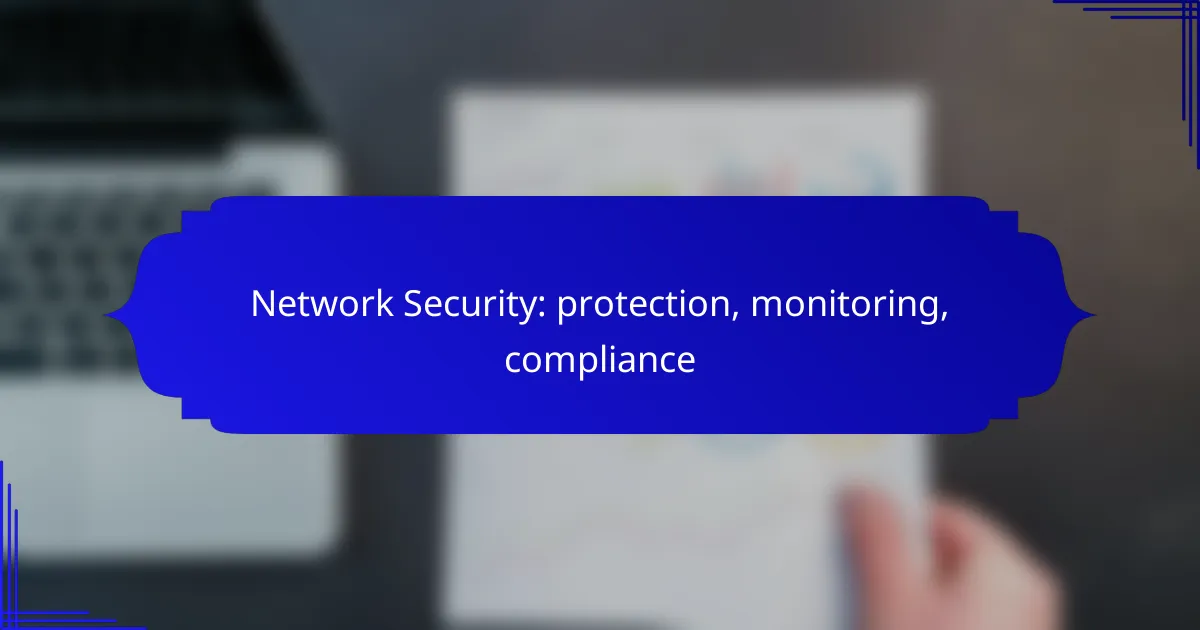Network security is essential for safeguarding data, monitoring activities, and ensuring compliance with regulations in today’s digital landscape. In New Zealand, organizations can leverage advanced solutions like Cisco Umbrella and Palo Alto Networks to enhance their security posture while adhering to standards such as the Privacy Act and ISO 27001. Continuous monitoring and effective response strategies are crucial for detecting threats and maintaining compliance in an ever-evolving threat environment.
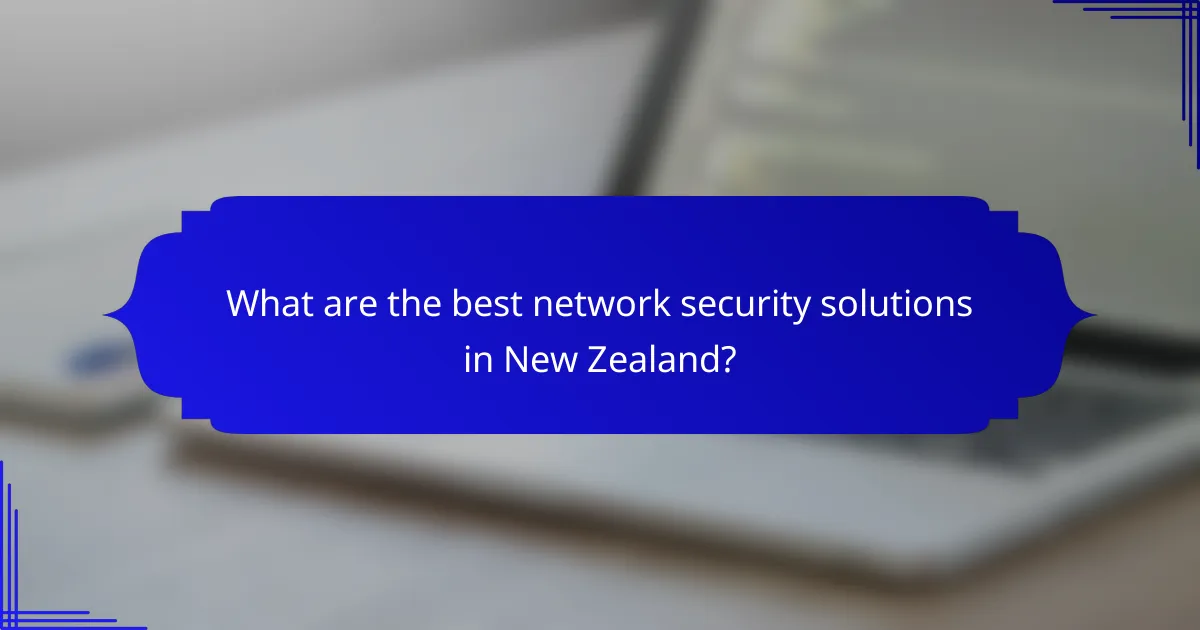
What are the best network security solutions in New Zealand?
In New Zealand, effective network security solutions include a variety of tools and services designed to protect data, monitor network activity, and ensure compliance with regulations. Leading options such as Cisco Umbrella, Palo Alto Networks, Fortinet FortiGate, Check Point Security, and IBM Security QRadar provide robust features tailored to local needs.
Cisco Umbrella
Cisco Umbrella is a cloud-delivered security solution that offers comprehensive protection against online threats. It functions by blocking malicious websites and content before they reach the network, utilizing DNS-layer security to prevent users from accessing harmful sites.
For New Zealand businesses, Cisco Umbrella is particularly beneficial due to its ease of deployment and scalability. It can be integrated with existing security tools, enhancing overall protection without significant infrastructure changes.
Palo Alto Networks
Palo Alto Networks provides advanced firewall solutions that combine traditional security measures with innovative threat detection capabilities. Their platform uses machine learning to identify and mitigate threats in real-time, ensuring that networks remain secure against evolving cyber threats.
Organizations in New Zealand should consider Palo Alto Networks for its comprehensive visibility and control over network traffic. This solution is ideal for businesses that require stringent security measures and compliance with local regulations.
Fortinet FortiGate
Fortinet FortiGate offers a range of next-generation firewalls that protect against a variety of cyber threats. These devices provide deep packet inspection and intrusion prevention, ensuring that malicious traffic is detected and blocked effectively.
In the New Zealand context, FortiGate is known for its high performance and flexibility, making it suitable for both small businesses and large enterprises. Its ability to integrate with other Fortinet products enhances overall security posture.
Check Point Security
Check Point Security delivers a unified threat management solution that combines firewall, VPN, and intrusion prevention features. This comprehensive approach allows organizations to manage security policies from a single platform, simplifying administration and improving response times.
For New Zealand companies, Check Point’s solutions are particularly appealing due to their strong emphasis on compliance and reporting capabilities. This makes it easier to adhere to local data protection regulations while maintaining robust security measures.
IBM Security QRadar
IBM Security QRadar is a security information and event management (SIEM) solution that provides real-time visibility into network activity. It analyzes data from various sources to detect anomalies and potential threats, allowing for quick incident response.
In New Zealand, QRadar is valuable for organizations that need to comply with strict regulatory requirements. Its ability to integrate with other security tools enhances overall situational awareness and helps in maintaining a secure network environment.
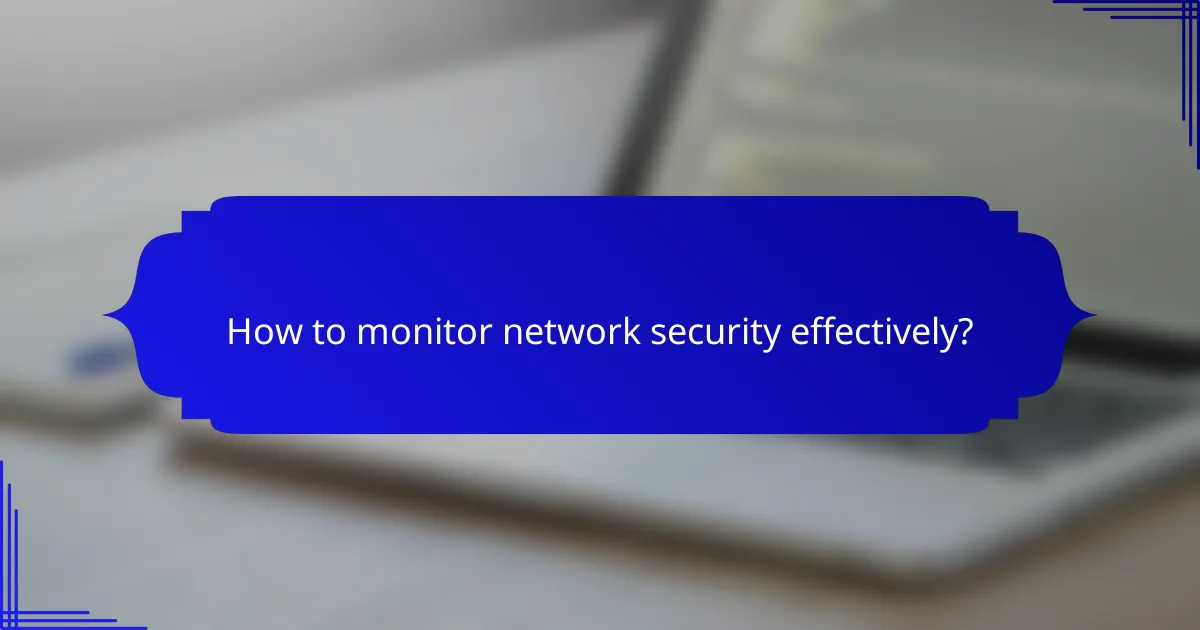
How to monitor network security effectively?
Effective network security monitoring involves continuous observation of network traffic and systems to detect and respond to potential threats. Key strategies include real-time traffic analysis, intrusion detection systems, and security information and event management (SIEM) solutions.
Real-time traffic analysis
Real-time traffic analysis involves monitoring network data as it flows to identify unusual patterns or anomalies. This can help detect potential security threats before they escalate. Tools like packet sniffers or flow analyzers can provide insights into bandwidth usage, application performance, and unauthorized access attempts.
When implementing real-time traffic analysis, consider the volume of data processed and the capability of your monitoring tools. Aim for solutions that can handle high throughput with minimal latency, ideally in the low tens of milliseconds, to ensure timely detection of threats.
Intrusion detection systems
Intrusion detection systems (IDS) are designed to identify unauthorized access or anomalies within a network. They can be classified into network-based (NIDS) and host-based (HIDS) systems, each serving different monitoring needs. NIDS monitors traffic across the entire network, while HIDS focuses on individual devices.
To maximize the effectiveness of an IDS, ensure it is properly configured to recognize both known threats and unusual behavior. Regularly update its signature database and conduct periodic reviews of its alert settings to reduce false positives, which can lead to alert fatigue among security teams.
Security information and event management (SIEM)
Security information and event management (SIEM) systems aggregate and analyze security data from across the network in real-time. They provide a centralized view of security events, enabling quicker identification of potential threats and compliance with regulations such as GDPR or HIPAA.
When selecting a SIEM solution, consider factors such as scalability, integration capabilities with existing tools, and the ability to provide actionable insights. Regularly review and fine-tune the SIEM’s correlation rules to ensure it effectively captures relevant events without overwhelming your team with alerts.
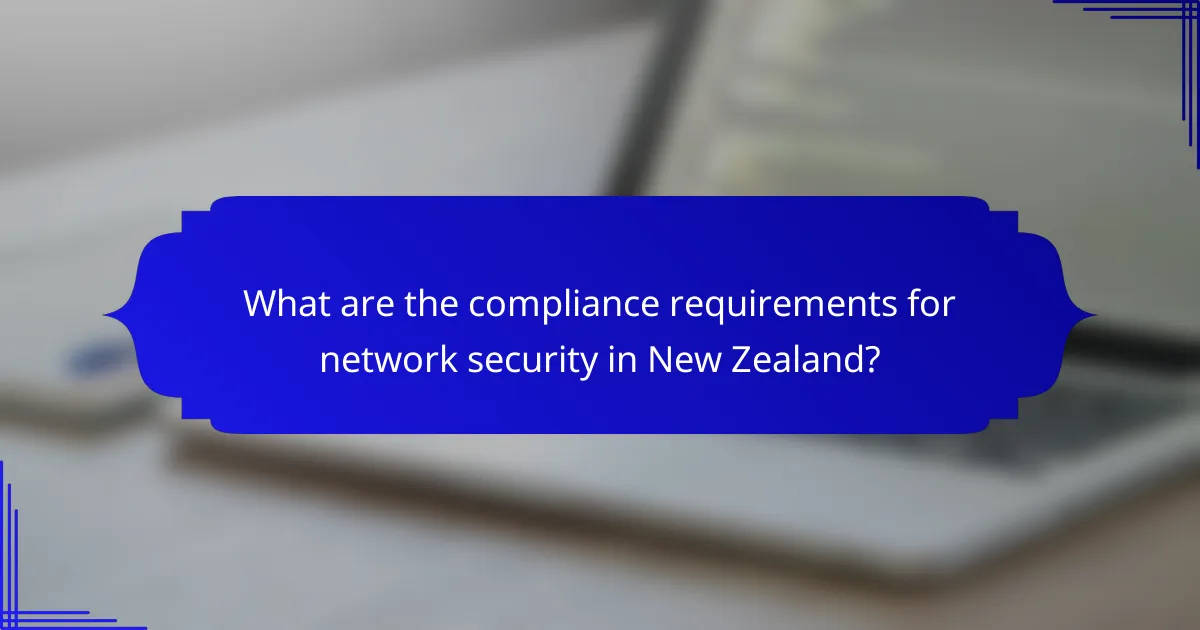
What are the compliance requirements for network security in New Zealand?
In New Zealand, compliance requirements for network security primarily involve adherence to the New Zealand Privacy Act, ISO 27001 standards, and considerations related to GDPR. Organizations must ensure they protect personal data, implement robust security measures, and remain aware of international regulations that may affect their operations.
New Zealand Privacy Act
The New Zealand Privacy Act 2020 mandates that organizations collect, use, and store personal information responsibly. This includes ensuring that data is kept secure and that individuals have the right to access and correct their information.
Organizations must implement reasonable security safeguards to protect personal data from unauthorized access, loss, or misuse. Regular audits and risk assessments can help ensure compliance with these requirements.
ISO 27001 standards
ISO 27001 is an internationally recognized standard for information security management systems (ISMS). It provides a framework for establishing, implementing, maintaining, and continually improving an organization’s information security.
To comply with ISO 27001, organizations must conduct risk assessments, define security policies, and ensure staff training on security practices. Certification can enhance credibility and demonstrate a commitment to data protection.
GDPR implications
While the General Data Protection Regulation (GDPR) is a European regulation, it has implications for New Zealand organizations that handle data of EU citizens. Compliance requires that these organizations implement strict data protection measures and ensure transparency in data processing activities.
Key considerations include obtaining explicit consent for data processing, ensuring data portability, and maintaining the right to erasure. Organizations should assess their data handling practices to align with GDPR standards, even if they are based outside the EU.
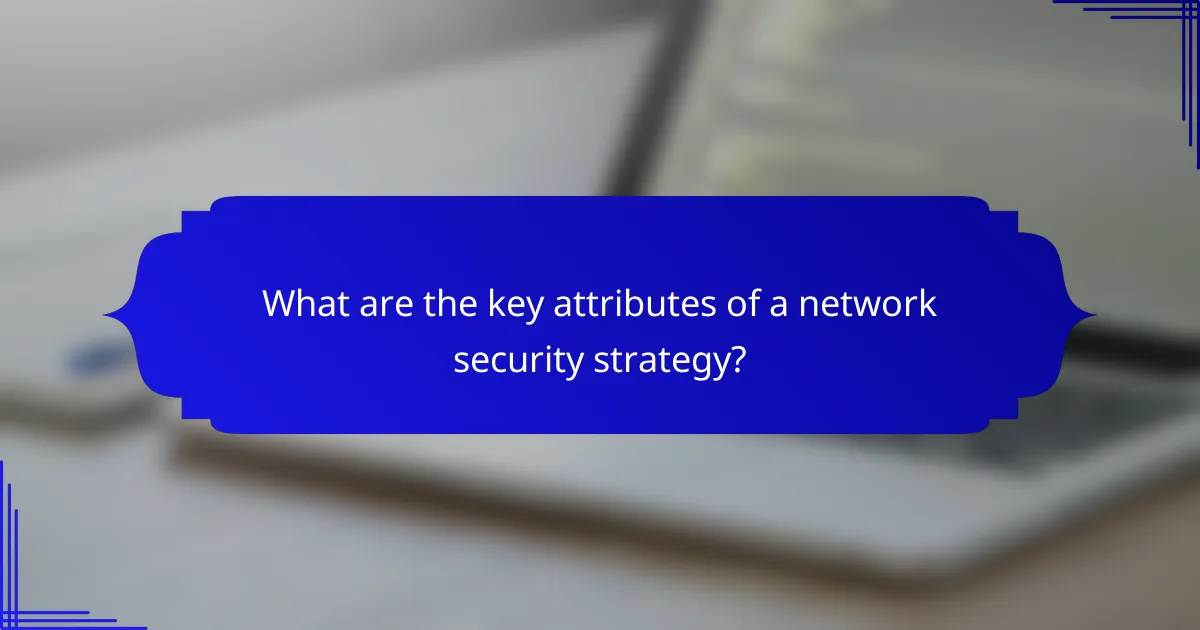
What are the key attributes of a network security strategy?
A robust network security strategy encompasses several critical attributes that work together to protect data and ensure compliance. Key elements include risk assessment, an incident response plan, and employee training programs, each playing a vital role in safeguarding network integrity.
Risk assessment
Risk assessment is the process of identifying and evaluating potential threats to a network’s security. This involves analyzing vulnerabilities, potential impacts, and the likelihood of various security incidents occurring.
To conduct an effective risk assessment, organizations should regularly review their network architecture, identify sensitive data, and assess the security measures in place. Tools such as vulnerability scanners and penetration testing can help uncover weaknesses.
Prioritize risks based on their potential impact and likelihood, focusing on high-risk areas first. Regular updates to the risk assessment process are essential as new threats emerge and the network evolves.
Incident response plan
An incident response plan outlines the procedures to follow when a security breach occurs. This plan is crucial for minimizing damage and restoring normal operations quickly.
Key components of an incident response plan include preparation, detection, analysis, containment, eradication, and recovery. Establish clear roles and responsibilities for team members to ensure a coordinated response.
Regularly test and update the incident response plan through simulations to ensure effectiveness and improve team readiness. This proactive approach can significantly reduce recovery time and costs associated with breaches.
Employee training programs
Employee training programs are essential for fostering a security-conscious culture within an organization. Regular training helps employees recognize potential threats and understand their role in maintaining network security.
Training should cover topics such as phishing awareness, password management, and safe internet practices. Consider using a mix of formats, including workshops, online courses, and simulated attacks to engage employees effectively.
Evaluate the effectiveness of training programs through assessments and feedback. Continuous education is vital, as cyber threats evolve rapidly, and keeping employees informed is key to a strong security posture.
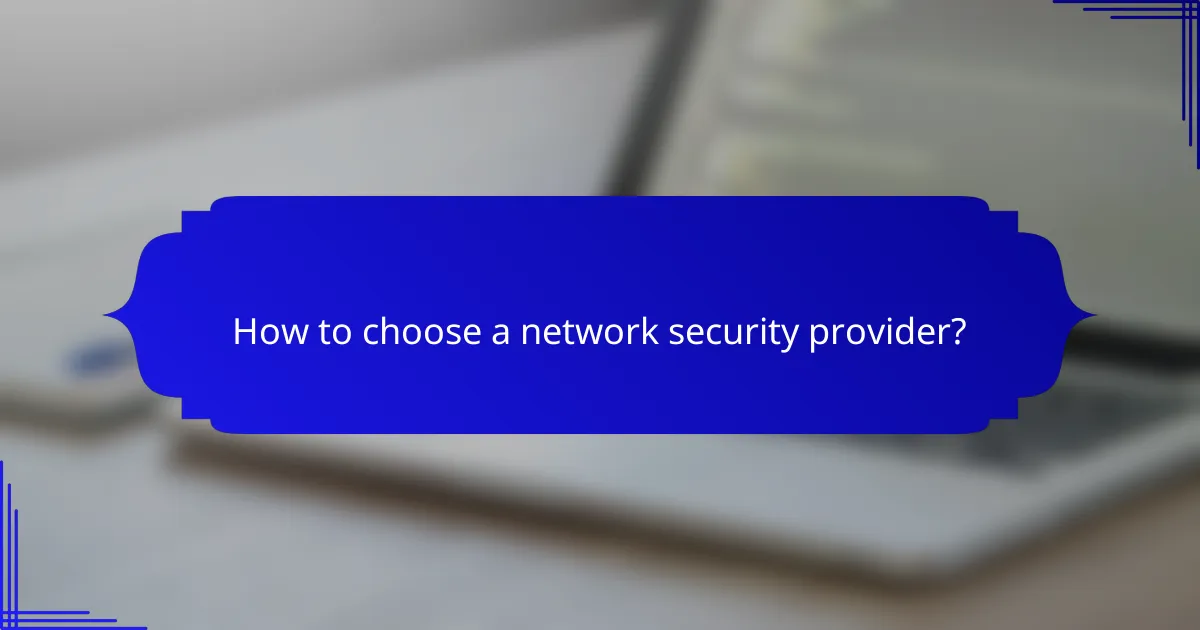
How to choose a network security provider?
Choosing a network security provider involves assessing their capabilities to protect, monitor, and ensure compliance for your network. Focus on their experience, customer feedback, and the specific services they offer to meet your organization’s needs.
Evaluate experience and expertise
When selecting a network security provider, consider their experience in the industry and the specific expertise they bring. Look for providers with a proven track record in handling security breaches and compliance with relevant regulations, such as GDPR or HIPAA, depending on your location and sector.
Ask about their certifications, such as CISSP or CISM, which indicate a level of professionalism and knowledge in the field. A provider with several years of experience and a diverse client base is often better equipped to handle various security challenges.
Check customer reviews
Customer reviews offer valuable insights into a network security provider’s reliability and effectiveness. Look for testimonials on their website, but also check independent review platforms to get a balanced view.
Pay attention to feedback regarding their response times, customer support, and the effectiveness of their security measures. A provider with consistently positive reviews and case studies demonstrating successful outcomes is likely to be a safer choice for your organization.
